An exact, subtle, pathological root is found by carefully observing intangible information. The TCM doctor must know where energy stagnates. Unfortunately, some TCM doctors or acupuncturists ignore intangible holistic information and TCM diagnosis, and rely on hospital medical data. This deviates from Oriental medicine, and is a disgrace to them and to TCM.
TCM and hospital diagnosis are completely different. Pulse diagnosis is fairly difficult to be mastered, particularly for 2–3-year part-time students, but also for 4–5-year full-time students majoring in TCM, because it requires special apprentice training. Inaccurate diagnosis influences patient treatment and TCM reputation.
To solve this problem, TCM diagnosis has been simplified to a new Dynamic Tongue Diagnosis (DTD). The questions, sniffing, visual inspection, and pulse diagnosis remain. Discovery of intangible energy circulation abnormality is emphasized, and Western medical data is de-emphasized. DTD, different from the original tongue diagnosis, simplifies diagnosis using the “Body Space” medicine theory.
The Principle and the Point of View of Tongue Diagnosis
Western medicine studies the physical body, with its cellular system and organs, through anatomy and biology. Oriental medicine recognizes the tangible body, but mainly works with the intangible energy system (spirit, meridians, aura/bio-energy light, energy field, etc.). The two medicines share cell theory, although the TCM view is one of “opening and closing”  — cells as “open” to emit and “closed” to absorb energy. Energy activities are “ascending and descending”
— cells as “open” to emit and “closed” to absorb energy. Energy activities are “ascending and descending”  .
.
The body is like a universe whose cavity is filled with energies that form an energy field (like in galaxies). These energies congregate, collide, emerge, activate, circulate, and react to generate new energies. They form energy fields like magnetic or gravity fields. The density and characteristics of these fields influence cell activities and health. These intangible energy fields include aura, meridian system, organ light, etc.
There are many spaces outside the cells, including several big spaces, filled with bio-energy fields. More and more research indicates that most health problems, especially cancers, are originally formed in the spaces around organs. Diseases form when spaces contain such overly concentrated, highly dense energy that cells cannot emit their energy to the space. When cell energy cannot be emitted, cells do not open, and energy stagnates. The damp heat trapped within cells or organs can lead to inflammation, cell mutation, and cancer.
Conversely, when the space’s energy field density is too low, cells easily emit but poorly absorb energy. Unable to properly absorb energy, an organ weakens, and functions poorly. This theory is a new development of TCM.
The activation, circulation, and exchange of energy is critical to life. When energy movement stops, life ends. When energy movement stagnates, diseases invade. Illness begins not with bacterial and viral infection, but with energy stagnation. An early-stage lung infection, for example, has no microorganism, but exhibits abnormally high energy density in the chest space and stagnant energy inside lung cells.
TCM does not usually directly attack the abnormalities, but adjusts the whole body to reinforce the energy circulation in the abnormal area. TCM treats the patient holistically, emphasizing prevention and self-healing.
According to TCM theory, the tongue connects with all inside organs through the meridian system, and is therefore the mirror and information center of the whole body. With our new energy circulation theory, the tongue becomes our most important diagnostic component and simplifies the TCM diagnostic technique.
Normal Tongue Appearance
The tongue normally looks like an oval, centered in the mouth like a fresh, pink, flat fish filled with vital energy in every flexing cell, and covered with a thin, pearly white coating. Above the fish/tongue, a slightly golden light reflects shadowy, unseen scenery, like the pre-dawn Easter sky. The entire tongue is beautifully symmetric, with a small middle cracked plain, surrounded by three low, moist “mountains” (left, right, and root), neither wet nor dry.
A pearly white coating indicates active, circulating, colliding, exchanging, un-stagnated, productive vital energy in all white body space areas where cells regularly open and close without stasis of matter, energy, blood, or fluid.
Dynamic Tongue Diagnosis and Prescriptions
Unlike in TCM’s original tongue diagnosis, the tongue is separated into three parts: the tongue body, the coating, and the shadow image. This diagnostic technique looks at the patient’s tongue size, flexibility, wetness, protuberances, cracks, coating, thickness (convex or concave), and color, through the coating and general spirit status, especially the dynamic shadow image. (See pic 1.Diagram of the tongue diagnosis.)
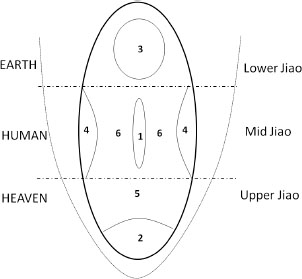
Basic Attention to The Tongue Diagnosis
To begin the tongue diagnosis, concentrate fully, using your heart as well as your eyes. Select the place and direction of natural light. Avoid food or drink that would influence perception. Use your knowledge and perception to prevent a false diagnosis.
Look at the coating
The coating indicates the cell’s exterior energy fields. Coating distribution indicates energy density, and thickness indicates accumulated energy. Localized thickness and a white/yellow coating indicate energy density in the corresponding viscera (See pic 1.Diagram of the tongue diagnosis maps the tongue’s corresponding viscera). For example:
| Yellow: | in the tongue’s upper Jiao indicates a lung infection — treat with Ban Lan Gen; in the middle Jiao indicates stomach problems — treat with Bin Lang; in the lower Jiao indicates kidney problems — treat with Bian Xu and Ju Mai; on the tongue’s tip shows heart problems — treat with Ban Lan Gen + Yuan Sen; |
| Red tipped: | indicates heat involving the Heart — treat with Mu Tong; |
| Sticky yellow: | mid-tongue shows accumulated heat in the small intestine — treat with Bai Tou Wong; higher with chest distension and cough — treat with Qian Hu, Da Qing Ye + Xing Ren; |
| Two yellow lines: | running parallel along the sides of the middle indicates liver problems; running to the lower Jiao indicates middle Jiao heat and intestine, bladder, or uterus problems — treat with Bai Tou Wong; |
| No coating: | in front indicates trachea energy deficiency, shortage of air and faint trembling; in the mid-tongue indicates deficient stomach Qi, and needs tonifying reinforcement — treat with Shan Yao, Yi Mi, Gou Ji, Ban Lan Gen; |
| Watery: | treat with Shan Yao, Yi Mi, Gou Ji, Ban Lan Gen + Bai Zhu. |
Look at the tongue body
First, decide whether the tongue is large or small, hard or soft, convex or concave somewhere, dry or wet, thick or thin. The tongue’s appearance indicates health conditions as follows:
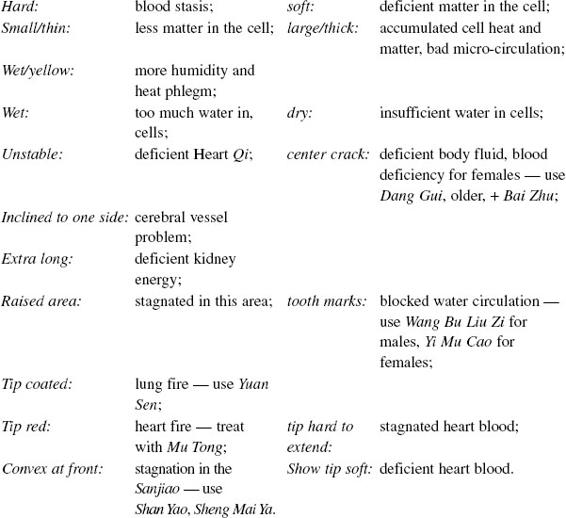
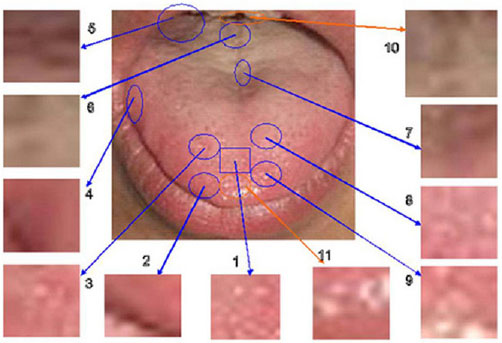
After research and clinical trials, doctors have achieved improved accuracy in the new techniques. Digital photos of the tongue are now strongly recommended. When stored in a patient’s computer file, the photos can be enlarged, and any part can be specifically analyzed (See pic 2.The Analyzed map of tongue on computer). A Computerized Tongue Database (CTD) increases the accuracy of diagnosis, and saves time as well.
Look at the image of the tongue
The key technique is catching a vague impression of the tongue’s shadow image (the tongue’s soul) at the moment when the tongue stretches out or turns back. There is a vague image above the tongue, by which to locate the illness area (See pic 1.Diagram of the tongue diagnosis). This is an accurate way to find the location of disease.
Simplified tongue diagnosis avoids the difficulties of relying mainly on pulse diagnosis. The skills are easy to learn, direct, and useful for TCM doctors and acupuncturists. In this way the most accurate diagnosis is performed (refer to the training booklet).
Digital Tongue Photo and Computer Analysis Program
As more doctors used the CTD method and as scientific research and technology developed, some techniques proved to be very helpful for accurate diagnosis. It is now strongly recommended to take a digital photo of the tongue, store it in the patient’s computer file, and analyze it using MS Photoshop or another photo editor program. It is then easy to enlarge or cut any part for specific analysis and detailed study (See pic 2.The Analyzed map of tongue on computer).
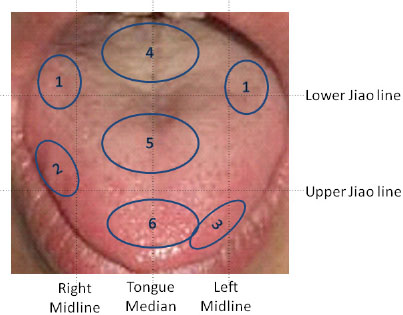
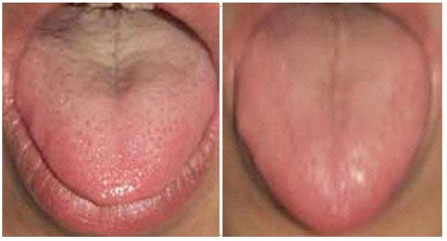
Using the Internet for “remote diagnosis,” patients can e-mail their tongue photo to a doctor, and receive herbal prescriptions from a doctor, across the world.
This technique’s advantages are:
(1)It stores vital information.
(2)It makes analysis, comparison, and further research very
convenient (See pic 3.Areas for analyzing the tongue and pic 4.Analyze the changes after three months)
(3)It establishes a Tongue Database to improve diagnosis, to further research, and to save time.
(4)It utilizes the superior (experienced) TCM doctor’s ability to diagnose at early stages of the disease, increases the survival rate, and lowers costs.
Dynamic Tongue Diagnosis Sample
On the left of pic 4.Analyze the changes after three months:
(1)The whole tongue is pale, soft, without vigor, and a bit damp. The middle is convex, thick, and full. This indicates a totally stagnated body, a low energy level, and a distended, full chest, with stagnated cell matter. The lung’s dispersing function is weak. There is excess phlegm and a distended spleen.
(2)The tip is red, with stasis points and a white bubble. The root’s thick and sticky coating indicates heat around the heart and kidney, low energy, and fatigue.
(3)The lower part is concave with a dark-pale image, which shows inability to energize stagnated matter. Energy cannot disperse to the Taiyang area of the back. The back feels heavy and tight, and the extremities have no energy.
Pei Lan releases the middle Jiao’s water line, and clears the dampness. Xiang Fu pushes up from the middle Jiao to energize stomach and spleen movement. The herb Gui Zhi opens the cell walls. Lian Qiao clears the heat around the heart and the upper Jiao. Du Huo pushes energy down to the lower Jiao and promotes circulation. Gou Ji reinforces the waist energy.
The picture on the right shows that the prescription significantly improved the health situation. The stasis with a white bubble is reduced significantly, but still indicates weak and slow circulation (See pic 4.Analyze the changes after three months).
Practice List with Use of Herbs
| (1) | Tongue body big, hard, and thick: matter stagnation in the cells, less vital energy. Huang Qi, Bian Xu; if the coating is yellow, add Xiang Fu + Da Bei. | |
| (2) | Tongue body small, soft and thin: lack of matter in the cells. Bai Zhu, Wu Wei Zi. | |
| (3) | Tongue enlarged, watery, and with teeth pressing: excess water and matter in the cells, less energy in space, water stagnation. +Wang Bu Liu Xing, Yi Mu Cao for females. |
|
| (4) | Tongue body small, thick, soft, and pale, with a dark point: lack of energy in the kidney and perineum (Huiyin) area. Huang Qi, Xiang Fu, Bai Zhu; if there is blood stasis, add Ren Dong Teng, Dan Shen. |
|
| (5) | Tongue body hard, with a thick, a sticky, and yellow coating: matter and energy stagnation, loss of the cells’ activity and function; probably cancer. Bai Tou Wong, Zi Shi Ying, Qiang Huo, Xiang Fu. |
|
| (6) | A high area in the middle front of the tongue: stagnation in the Middle Jiao; the energy canot go through and the circulation stops. Bin Lang, Xiang Fu. |
|
| (7) | Sticky yellow coating at the root of the tongue: energy stagnation in the Lower Jiao space. Bai Tou Wong, Cang Shu, Pu Gong Ying, Bian Xu, Qu Mai. |
|
| (i) | Sticky, yellow coating with water — water stasis. | |
| (ii) | Dry on the root of the tongue — with heat causing dryness. | |
| (8) | No coating in the root of the tongue: Yin deficiency in the Lower Jiao, damaged kidney essence. Zi Shi Ying/Qiang Huo 7:4; if there is more urine and sweat, add Wu Wei Zi/Bai Shao 7:6; for a problem on the left side, add Chao Zao Ren; on the right side, add more Yie Jiao Teng; with the head, add Shi Chang Pu and Bai Ji Li. |
|
| (9) | Yellow coating on the middle: heat accumulated in the stomach. Add Bin Lang. | |
| (10) | Less coating and a pale tongue: less energy in space. Add Bai Shu. | |
| (11) | Pale coating with a soft, quivering tongue: Qi deficiency. Add Huang Qi. | |
| (12) | Left side body problem: the left atrium supplies less blood. Add Chao Zao Ren. | |
| (13) | Right side body problem: less blood returns to the left heart. Add Yie Jiao Teng. | |

